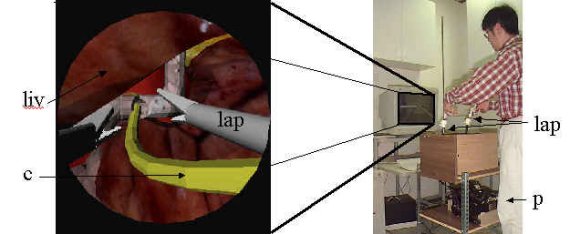
 |
|||||||
Medical Simulations |

Medical Simulation is an important application of haptics that is emerging rapidly. Each issue in medical simulation is challenging right from modeling to training medical personnel. Modeling Challenges:Modeling soft tissue is an important issue in medical simulation because they exibit complex material properties. They are non-linear, anisotropic, viscoelastic and nonhomogeneous (usually layered). Moreover, soft tissues deform considerably under the application of relatively small loads. Because of these and many other reasons it is very difficult to obtain in vivo material properties of living tissues. Our facility for measuring in vivo material properties of living tissues uses a haptic feedback device and a mechanical stimulator.Real time simulation of these soft-tissue is challenging because the contact points between the tool and the tissue can occur at other than nodal points. Cutting, for example, is a computationally expensive task since it requires meshing and remeshing. Achieving this poses significant obstacles in real time application, given the high rate requirement of haptic rendering. We have developed meshless numerical schemes for medical simulation. Triangle is widely used as a modeling and rendering primitive in representing
continuous surfaces since it exploits coherence effectively while graphically
rendering. As the scene complexity increases, this way of exploiting coherence
becomes expensive especially when the size of the triangle is less than
that of a pixel. We use points as primitives for
modeling geometry and haptics. Simulation Challenges:Performing epidural injection is a clinical task that demands a high level of skill and precision from physician. Our epidual injection simulator provides the user with realisitic haptic feel of interactions between the needle and vertebra or soft tissues encountered during an actual procedure.Minimally invasive surgery has been used in a range of procedures since
the early sixties. Unfortunately, the lack of generalized guidelines for
appropriate training, and credentialing has led to the widespread, unregulated
introduction of laparoscopy, which has resulted in numerous operative
complications. Advanced laparoscopic procedures (e.g hernia repairs, antireflux
procedures, colectomy) require significantly greater skills than those
for simple extirpative procedures (e.g cholecystectomy, splenectomy, adrenalectomy).
The goal of our Laparoscopic Simulator is to
simulate these advanced procedure. Rendering Challenges and Techniques:Realistic rendering of anatomical objects using traditional texture mapping techniques is not successful because of the texture stetching problem. Visual effects in surgical simulations such as glistening has been a challenge. We have used environment mapping techniques for achieving visual realism in our simulations.High update rates of haptic rendering poses significant challenges for medical simulations. We have used several simple techniques to overcome some of these challenges. Training:Many surgeons believe that successful surgical training require highly realistic simulation trainers, even though low fidelity simulators have been used effectively for training in many domains. Our study aims at unravelling the relationship between the fidelity of simulation and training effectiveness.Publications:Useful Links: |
| Last Updated: May 8, 2002 1:45 PM | Comments: David Schloerb |